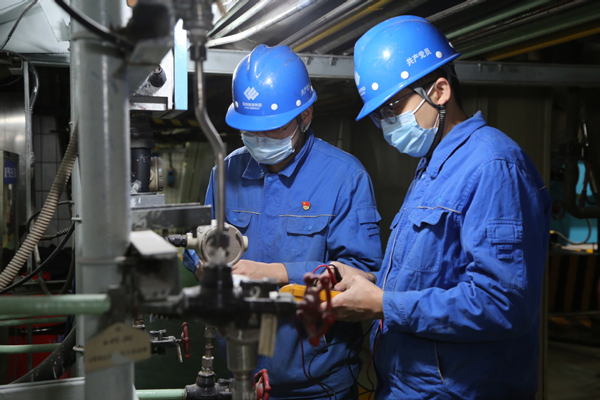

Technicians of China Energy Investment Corp check equipment at the Dagang power plant in Tianjin. [Photo/China Daily]
For the past few decades, coal-fired power plants have powered factories and warmed up homes across the country, boosting China's energy market.
The Dagang power plant in Tianjin, a pivotal player in the national energy landscape since the commissioning of its first unit in 1978, has been one such.
The plant, once the largest single-unit capacity thermal power generator in China, has fostered industrial growth and supported economic development in North China for decades with stable and ample power supply.
However, as China accelerated its green and low-carbon energy transition in a bid to achieve carbon peak before 2030 and carbon neutrality before 2060, the Dagang power station, operated by China Energy Investment Corp, the world's leading coal supplier, has decided to adopt sustainable practices with advanced technology.
The power plant is currently undergoing technological upgrades aimed at enhancing overall efficiency and has introduced advanced equipment to maximize energy output while minimizing the environmental impact.
To replace four 328-megawatt units, the power station is constructing two high-efficiency ultra-supercritical coal-fired cogeneration units, each with a capacity of 660 MW.
The units will employ comprehensive dust removal measures. Emissions of sulfur, nitrogen and particulate matter will be significantly lower than national standards, it said.
Additionally, the units' cooling method will also enable zero emissions of solid waste and warm water discharge to further facilitate marine ecological preservation.
Compared to existing units, the replacement will reduce the burning of 300,000 metric tons of coal per year, while cutting carbon dioxide emissions by approximately 700,000 tons, said Wang Song, chairman of the Dagang power station.
The planned replacement project has completed all preliminary supporting documents and policy procedures and is scheduled to start in October this year. Upon completion, these projects are expected to provide heating to an area of about 28 million square meters, he said.
In a bid to diversify its energy sources, the plant has also incorporated renewable energy solutions such as solar power. Distributed solar panels are now dotting the landscape surrounding the facility, harnessing natural resources to generate sustainable electricity.
Since it became connected to the grid in 2021, the 3.78-MW distributed photovoltaic system within the station has generated around 5.03 million kilowatt-hours, reducing carbon dioxide emissions by around 4,200 tons.
As China plans to phase down coal usage between 2026 and 2030, many facilities like the Dagang power plant are implementing advanced technologies to reduce emissions while adopting energy-efficient practices, said Lin Boqiang, head of the China Institute for Studies in Energy Policy at Xiamen University.
The process of phasing down coal in favor of cleaner energy sources involves not only integrating renewable energy sources, but also decommissioning outdated facilities. Such transitions contribute to environmental conservation and promote technological innovation, while creating new opportunities for sustainable economic growth.
The installed capacity of wind and solar power will exceed that of coal-fired electricity and account for about 40 percent of the total installed capacity by the end of this year, according to the China Electricity Council.
China's cumulative installed capacity of new energy power generation is expected to surpass that of coal for the first time this year, amid optimized power supply capacity and accelerated transition to green energy sources, said Dong Zengbo, deputy head of the council's statistics and data center.
The parent company of Dagang power station, China Energy Investment Corp, achieved a record in installed renewable energy projects last year, as the company accelerated its green energy transition while ensuring domestic energy security.
Power generation capacity last year reached 320 million kilowatts, with renewable energy accounting for 110 million kW, representing 35.5 percent of the total, said the company.
Its annual coal production reached 620 million tons last year, with coal sales reaching 830 million tons, contributing to about one-sixth of the national total, and ensuring stable domestic energy supply, it said.

Copyright © 2024 Tianjin Municipal People's Government. All rights reserved.

Copyright © 2024 Tianjin Municipal People's Government. All rights reserved.